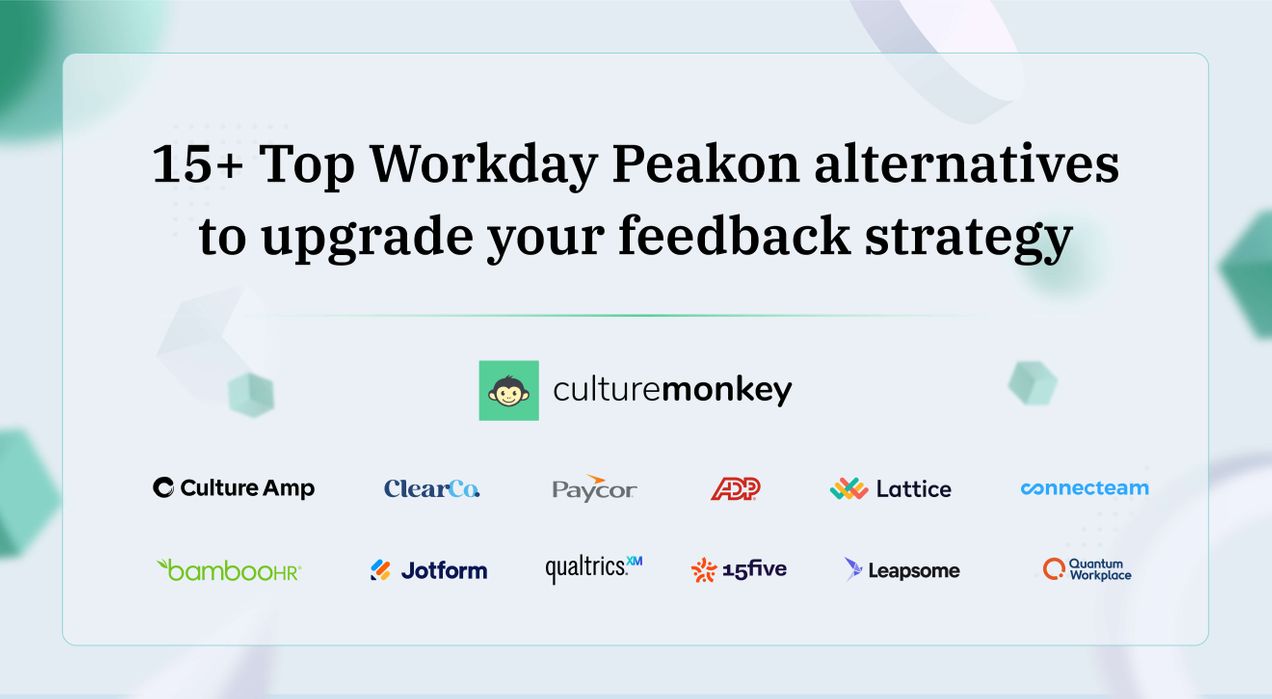Employee engagement survey email: Templates, enterprise strategy, & best practices for 2025

Remember the last time you got invited to a party through word of mouth? Someone casually said, “Hey, there’s something happening Saturday, you should come.” You weren’t sure if the invite was really meant for you, or if it was just a passing suggestion.
Now compare that to receiving an invitation with your name on it. The details were clear, the message felt intentional, and you knew your presence mattered. One invite feels optional, the other feels personal.
That’s the same difference an employee engagement survey email can make. In this blog, we’ll explore how enterprises can craft survey emails that feel personal, trustworthy, and worth responding to.
TL;DR
What is an employee engagement survey email?
An employee engagement survey email is a message sent by HR or leadership to invite employees to participate in a survey about their exit surveys and workplace experience. It typically includes a brief explanation of the survey’s purpose, a clear call-to-action, the expected time to complete it, and a link to access the survey.
Considering that, the Gallup employee engagement survey shows 51% of employees are disengaged in the workplace, this email acts as the starting point for the feedback process. Whether it's a large-scale annual engagement survey or a quick pulse check, the email sets the tone. If done right, it encourages employees to share honest input by framing the survey as meaningful and easy to complete. If the email is vague or rushed, it can lead to poor response rates or disengagement.
A good employee engagement survey email balances clarity, empathy, and intent. It explains why the survey matters, reassures employees about confidentiality, and emphasizes how their feedback will be used to create a positive workplace culture. It may also mention previous survey outcomes to show that the organization listens and acts.
More than just a notification, this email is a trust-building opportunity. It can either boost participation and quality of responses or undermine the whole initiative. That's why designing an effective email isn’t optional. It’s essential to the success of any engagement strategy.
TL;DR
An employee engagement survey email is the first step in collecting honest feedback from employees. It sets the tone for participation, explains the survey’s purpose, and ensures trust through clear communication.
In large organizations, it’s a critical part of the employee engagement survey communication strategy that drives better culture, retention, and actionable insights.
Why large organizations struggle with employee engagement survey emails?
In large organizations, sending a survey email isn’t as simple as hitting "send." With scale comes complexity and when survey communication misses the mark, response rates suffer.
Here’s where most enterprise employee feedback strategies fall short when it comes to survey emails:
- Lack of personalization across regions or departments: One-size-fits-all emails don’t resonate with diverse, global teams. People are more likely to ignore emails that feel generic or irrelevant.
- Unclear subject lines that kill open rates: If the purpose isn’t instantly obvious, employees won’t click. This is a major reason why employee survey email open rates dip below benchmarks.
- No clarity on anonymity or how responses will be used: Employees need to know their feedback is safe and that action will follow, otherwise, trust breaks down.
- Poor timing across time zones and team schedules: Sending during busy cycles, holidays, or off-hours results in missed or ignored emails.
- Too formal, corporate, or robotic in tone: Emails that sound like legal notices feel cold and disengaging. Human, empathetic language performs better.
- Survey fatigue from frequent, overlapping asks: When employees get too many surveys or emails with unclear purpose, they start tuning out.
- No follow-up or action after previous surveys: Without visible change from prior feedback, employees lose motivation to participate again.
What should an enterprise-grade employee engagement survey email include?
Sending a reminder email isn’t about pushing people, it’s about giving them another opportunity to speak up. But when done poorly, reminders can come off as spammy or robotic. The key is to gently nudge your employees while keeping the tone respectful, clear, and human. Here’s how to do it right.
- Keep the tone warm, not transactional: A reminder shouldn’t feel like a task update. Drop the stiff “This is your final notice” language. Instead, go for a tone that sounds like you’re checking in, not chasing. Think: “Just wanted to gently remind you…” or “If you’ve already completed it, thank you—if not, there’s still time.”
- Show you respect their time: Time is currency in any workplace. Start the survey follow-up email with something like, “We know your inbox is busy, so we’ll keep this short.” Acknowledging their workload up front helps lower resistance and makes them more receptive to your message.
- Re-explain the ‘why’ behind the survey: A gentle reminder is also a second chance to reinforce purpose. Let employees know that their feedback doesn’t just go into a black hole. A line like “Your insights directly influence the programs we build” adds meaning and makes the employee engagement survey email feel more personal.
- Include one clear call-to-action (no fluff): Don’t bury the survey link in a paragraph or clutter the email with multiple links. Use a bold button or line that says something like: “Take the 2-minute survey now.” Your email survey template should be built for quick action—don’t make them hunt for the next step.
- Mention a specific closing date or time window: People are more likely to act when they know the clock is ticking. A simple line like “Survey closes Friday at 5 PM” gives them a frame of reference. It also signals that this isn’t an open-ended ask, which can increase urgency without being aggressive.
- Format for clarity and quick scanning: Even the best message can fail if it’s visually overwhelming. Use short paragraphs, break up text with line spacing, and emphasize key points. Your survey mailer template should guide the eye to what matters: why the email exists, what the reader should do, and by when.
How to craft an email subject line that drives opens?
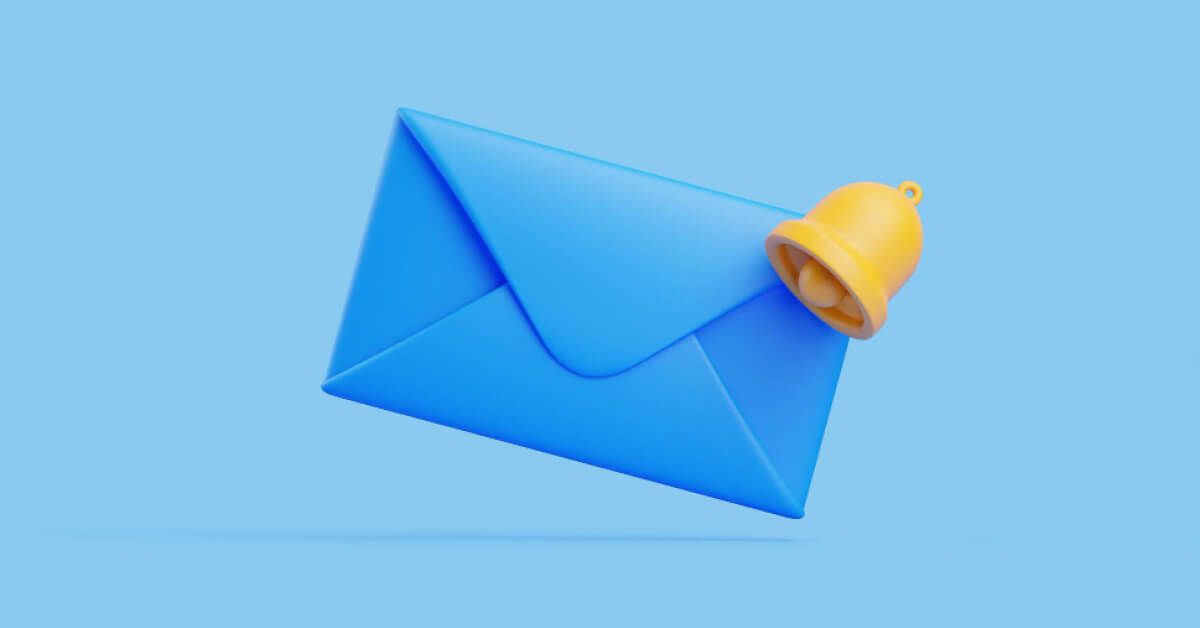
The subject line is your first and sometimes only chance to catch attention. If it blends in with other corporate emails, it’s likely to be ignored. A strong subject line makes the employee pause, click, and engage.
TL;DR
A strong subject line is crucial to grab attention and boost survey email opens. Keep it specific, conversational, timely, and under 50 characters for mobile-friendliness.
Avoid vague language and create urgency where appropriate. A/B test different approaches to see what resonates best, using data to refine and ensure your message stands out in crowded inboxes.
- Make it specific, not vague: Avoid generic phrases like “We’d love your feedback.” Instead, get to the point. A subject like “Help shape your team’s 2025 experience” or “2 minutes to share what matters” is more actionable and clear.
- Use a conversational tone: Write like you’d talk to a colleague. Subject lines that sound natural perform better. “Quick favor: Tell us how we’re doing” feels more human than “Engagement Survey Notification.”
- Create a sense of relevance or timeliness: Employees are more likely to open an email if it feels current. Adding a time cue like “This week only” or “Closes Friday” can spark urgency and drive faster clicks.
- Keep it short and mobile-friendly: Long subject lines get cut off on mobile. Aim for under 50 characters. Something like “Your voice. Your impact.” or “Tell us what’s working” delivers the message cleanly.
- A/B test to learn what works: Don’t assume—test. Use your employee engagement survey software to try different subject lines and compare results. What works for one team might flop with another, and data helps refine your message over time.
How long should your engagement survey email be?
An engagement survey email should be short enough to respect your employees’ time but long enough to give them the context they need. The sweet spot is typically between 100 to 150 words. That gives you just enough room to explain the purpose, what to expect, and how their feedback will be used, without overwhelming the reader.
A common mistake is over-explaining. When the employee engagement survey email becomes a wall of text, most people won’t even finish the first paragraph. Instead, keep it simple. Use short sentences, bullet points (if needed), and direct language to guide the reader toward one action: clicking the survey link.
Your message should answer three quick questions: Why are we asking for feedback? How long will it take? What happens next with employee feedback? That’s all employees really need to know before deciding whether to engage.
If you're unsure whether your message is too long or unclear, test it. Try sending a more concise survey request email sample to one group and a slightly longer version to another. Use your survey follow-up email to reinforce key points, rather than cramming everything into the first message.
Survey email templates for enterprises (Initial, Reminder, Final Call)
Writing survey emails at scale isn’t just about sending links, it’s about building trust, clarity, and participation across a diverse workforce. The tone, timing, and structure of your message directly impact whether employees engage or ignore.

You don’t need a novel—just the right words, tone, and timing. A well-structured employee engagement survey email shows employees that their voice matters. Below are four ready-to-send templates, especially the post-event feedback survey templates, designed for different use cases.
TL;DR
Effective survey emails balance clarity, trust, and timing. Start with an initial invite that sets purpose and ensures anonymity, follow up with a gentle reminder for non-respondents, and close with a final call that creates urgency without pressure.
This sequence helps enterprises drive stronger participation and more meaningful employee feedback at scale.
Below are three email templates for feedback surveys you can use to guide your outreach, from launch to final call.
Survey launch email template
Subject Line : Tell us how we’re doing (Your feedback is anonymous)
Hi ( Employee Name),
We’re committed to making [Company Name] a workplace where everyone can thrive and that starts with listening.
Our latest [Survey Name] is now live, and we’d love your honest feedback. It’s anonymous, takes less than 3 minutes, and helps us improve how we support you and your team.
Why this matters:
Your input helps shape our culture, improve manager support, and drive real change. This isn’t just a survey, it’s your opportunity to influence what comes next.
📅 Deadline: [Insert date]
🔒 Anonymous & secure – no identifying data is shared
✅ Takes just 2–3 minutes
[Take the Survey Now] ← (CTA Button)
Thank you for your time.
Regards,
The [People/HR/Employee Experience] Team
Reminder email template
Subject Line : In case you missed it, we’d love to hear from you
Hi( Employee Name),
Just a quick reminder, our [Survey Name] is still open, and we’d really love to hear your thoughts.
If you’ve already taken it, thank you. If not, there’s still time. It only takes a couple of minutes, and your feedback helps us understand what’s working and what could be better.
We know your schedule’s busy, so we’ve kept this short and anonymous. Your voice helps us improve how we support teams, build programs, and shape the culture we all experience every day.
🗓️ Survey closes: [Insert date/time]
⏱️ Takes just 2–3 minutes
🔐 Your responses are anonymous
👉 [Take the Survey] ← (CTA Button or Bold Link)
Thanks again for helping us build a better place to work.
Warmly,
[Your People/HR Team]
Final call email template
Subject line: Final call: Help us improve your experience at [Company Name]
Hi [First Name],
We noticed you haven’t had a chance to complete the [Survey Name], and today’s the final day it’s open.
Totally understand if things have been busy, but if you can spare just 2 minutes, we’d be grateful to hear from you. Your feedback plays a real role in shaping how we support you and your team moving forward.
We’re only reaching out to those who haven’t submitted responses yet, so if you’ve already started but didn’t finish, this is your gentle nudge to wrap it up.
🗓️ Closes: [Insert final date/time — e.g., Today at 5 PM]
⏱️ Just 2–3 minutes to complete
🔐 Fully anonymous
👉 [Take the Survey] ← (CTA Button or Bold Link)
Every voice matters and yours could help spark real change.
Thanks for considering,
[Your People/HR Team]
7 Example subject lines that get your employee engagement survey emails opened
Not all survey email subject lines should sound the same, they need to match the stage of the survey, the tone of your brand, and the mindset of your employees. Below are seven high-converting subject line categories, with examples that work especially well in large organizations.
Warm and human-led
These subject lines create an immediate emotional connection. They work well when trust and authenticity are key, especially in early outreach. Avoid robotic language and speak like a human checking in.
- “We’re listening, tell us how work’s going for you”
- “How are you really feeling at work?”
Time-sensitive and deadline-driven
When the clock is ticking, a clear deadline can drive action but without sounding cold or transactional. These subject lines highlight urgency while still respecting the recipient’s autonomy.
- “Last day to complete your engagement survey”
- “Closes today: 2-min survey to share your thoughts”
Feedback-oriented and participative
These subject lines reinforce that this isn’t a broadcast, it’s a conversation. Employees are more likely to engage when they know their feedback will be heard and used to shape real outcomes.
- “Your feedback helps us improve what matters most”
- “Got thoughts about your team or role? We’re all ears”
Respectful and time-aware
Acknowledging your employees' time increases the chance they'll open and respond. These subject lines work well for reminders, especially in time-pressed or high-volume communication environments.
- “Quick favor? 2-minute survey inside”
- “Have 2 minutes? We’d love your input”
Vision-driven and impact-focused
These subject lines appeal to purpose and progress. By linking the survey to long-term cultural improvements, they help employees feel like active contributors to something bigger.
- “Help shape what’s next at [Company Name]”
- “Your voice = a better workplace”
Reminder and follow-up
Used mid-campaign, these subject lines gently nudge non-respondents. They avoid pressure and instead reframe the survey as an open invitation that’s still available.
- “Just checking in, still time to share your thoughts”
- “Haven’t had a chance yet? Survey’s still open”
Brand voice or culture-specific
If your company uses a distinct tone internally, these subject lines can reinforce that culture. They’re often used to keep engagement high while staying on-brand.
- “You talk. We listen. Together, we grow.”
- “Help us keep [Company Name] a great place to work”
Best time to send an employee engagement survey email in global teams
Timing your employee survey email is just as important as writing it well. If you send it during a hectic time or right before a weekend, it’s more likely to be missed, ignored, or deleted. Most research suggests that midweek, specifically Tuesdays, Wednesdays, or Thursdays, delivers the highest response rates for your future endeavors.
These are days when employees are more settled into their workflow and not yet distracted by the weekend rush. As for time, late mornings between 10:00 AM and 11:30 AM work well. This window hits the inbox when people have cleared the early-day chaos but haven’t yet switched into deep-focus mode.
Avoid sending emails after 4:00 PM or early on Monday mornings, both times when engagement with future employees tends to drop.
Of course, your team’s schedule matters. If your company has a global or hybrid setup, use your employee engagement survey software to segment by time zone. Test different windows and adjust based on actual performance.
Your email survey template might be perfect, but if the message lands at the wrong moment, it can go unnoticed. Combine smart timing with strong messaging and a thoughtful survey follow-up email strategy to maximize participation.
How to personalize survey emails at scale across regions and departments?
Personalization boosts engagement, but doing it manually for hundreds of employees? Not realistic. The trick is to automate small touches that feel human. Here’s how to personalize your employee engagement survey emails at scale with input from the leadership team, including onboarding surveys, without losing relevance or efficiency.
- Use dynamic fields for names and departments: Most email platforms let you insert first names, team names, or job titles using placeholders. So “Hi [First Name]” becomes a warm opener. It’s a simple way to make the survey mailer template feel less like a blast.
- Reference recent initiatives or milestones: Mentioning a recent company event or product launch makes the email feel timely. When employees see context they recognize, the message feels curated, not copied.
- Segment your audience: Use your employee engagement survey software to segment by department, region, or role. Tailor each version of the email survey template slightly—language, tone, or call-to-action—so it resonates better with each group.
- Change the sender based on the audience: People are more likely to engage when the email comes from someone they trust. For example, messages to the sales team might come from their VP instead of HR.
- Mention past feedback outcomes: Employees engage when they feel heard. If a previous survey led to a real change, reference that. “Last quarter, your feedback led to…” can boost trust and participation.
- Customize your follow-up cadence: Instead of blasting the same survey follow-up email to everyone, adjust the timing. Early responders don’t need reminders. Tailor nudges only to those who haven’t participated yet.
How to A/B test your engagement survey email strategy?
You don’t need to guess what works, A/B testing helps you make decisions based on data, not gut feelings. When it comes to crafting the ideal employee engagement survey email, even small changes can impact open and click-through rates. Here’s how to run meaningful A/B tests without overcomplicating it.
- Test one variable at a time: Don’t try to test everything at once. Pick one element—subject line, sender name, CTA wording, and run the test on that. For example, test “Help us improve your workday” vs “2 minutes to share your feedback” to learn what tone performs better.
- Segment your audience fairly: Split your audience evenly and randomly to avoid bias. This ensures that the test results reflect true behavior differences, not demographic quirks. Your employee engagement survey software often includes built-in A/B testing features to handle this automatically.
- Define what success looks like: Are you measuring opens, clicks, completions, or all three? Be clear about what you want the test to tell you. If you’re testing a subject line, focus on open rate. For CTA buttons or a new survey request email sample, focus on clicks.
- Give your test enough time (and volume): Avoid judging results too early. Give each version time to collect enough data, usually at least 24 to 48 hours with a decent sample size. A rushed test can lead to false conclusions that hurt your survey mailer template strategy in the long run.
- Apply learnings and keep iterating: Once you have a winner, don’t stop there. A/B testing should be ongoing. Use what you learn to update future survey follow-up emails, reminders, or even sender tone. Incorporating form validation also ensures that the emails collected through your forms are accurate and deliverable. Each test helps you craft smarter, more effective campaigns over time.
Common mistakes HR teams make when sending survey invites
Even well-meaning survey campaigns can fall flat because of simple missteps. When employees ignore a survey invite, it’s often because the message didn’t land the way HR expected. Let’s look at the common mistakes that quietly sabotage your engagement efforts in professional development.
TL;DR
HR survey invites often fail due to avoidable mistakes like using generic senders, cluttered messages, vague purposes, and weak subject lines. Skipping confidentiality assurances or personalization lowers trust and engagement.
Failing to follow up strategically also hurts participation. Clear, concise, and thoughtful emails—personalized and transparent—encourage honest feedback and higher response rates, making surveys far more effective.
- Sending from a generic or unknown sender: If the email comes from a no-reply address or someone employees don’t recognize, trust drops. People are more likely to open and engage when the sender feels familiar or authoritative.
- Making the email too long or cluttered: A long, wordy message is easy to skip. Employees don’t want to dig through paragraphs just to find out what you want. Hence, you should keep your email text concise, and you can do it efficiently using an AI summarizer tool. A clear and concise survey mailer template works better.
- Failing to explain the purpose of the survey: When the email doesn’t answer “why should I care,” it gets ignored. Explain how the survey results will be used and what actions may follow based on the new hire feedback survey results.
- Not reassuring employees about confidentiality: Employees hesitate to share honest feedback about training programs if they’re unsure whether it’s anonymous. If your employee engagement survey email skips this reassurance, you’ll likely get fewer honest responses.
- Poor subject line choices: Subject lines that are vague or look like generic company updates won’t get opened. You need something that feels timely, personal, and relevant to boost open rates.
- Skipping personalization entirely: A message that feels like it was sent to “everyone” reduces engagement. Even simple touches like a first name or department reference make the email feel more intentional.
- Forgetting to follow up strategically: One and done doesn't work. Without a timely survey follow-up email highlighting ongoing efforts, participation lags. The follow-up shouldn’t feel like spam—it should be a thoughtful reminder that encourages action.
Top employee engagement platforms for global survey email delivery
When you're managing a workforce spread across regions, time zones, and cultures, delivering employee engagement surveys via email becomes a logistical and strategic challenge. Enterprise HR teams need tools that don’t just send surveys, but localize, personalize, and automate the entire experience.
From timing to compliance, the right platform can make or break your survey participation rates. Here are the top platforms built to handle survey email delivery at global scale:
1. CultureMonkey
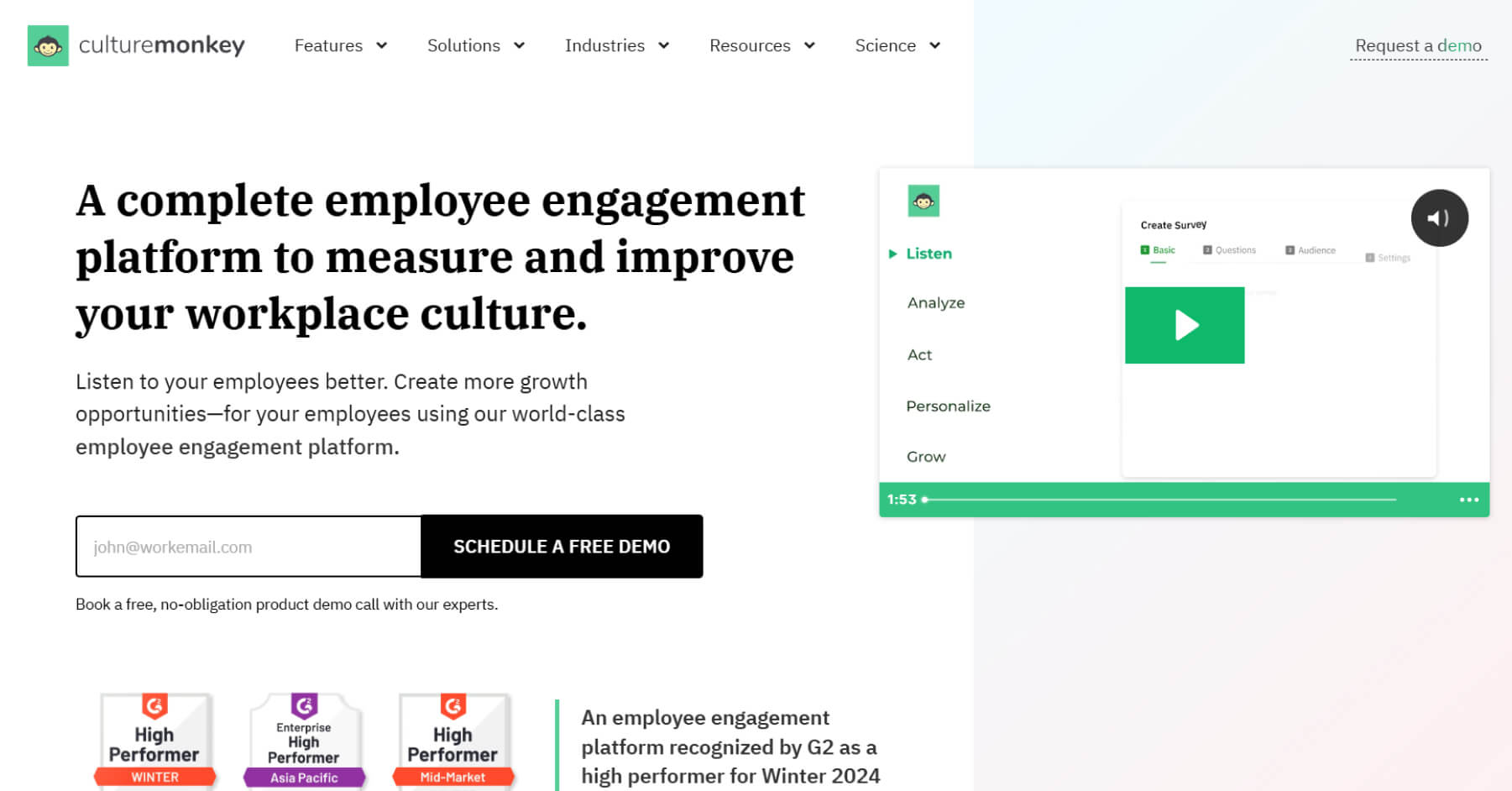
CultureMonkey is a global employee engagement platform built for enterprises that need scale, security, and actionability. Designed with People Science at its core, it enables HR leaders to automate engagement surveys, personalize communications, and deliver insights across 190+ countries.
With enterprise-grade compliance, multilingual support, and seamless HRIS integrations, CultureMonkey helps decision-makers build trust, increase response rates, and turn employee feedback into measurable cultural impact.
| Feature | Advantages |
|---|---|
| Enterprise-grade security | Built with GDPR, SOC 2, and ISO standards to protect employee data end-to-end. |
| Seamless data migration | Move from legacy survey tools without losing history, benchmarks, or insights. |
| Out-of-the-box integrations | Connect with Workday, SAP, Slack, Teams, and HRMS tools with minimal IT effort. |
| Guided onboarding support | Hands-on help from specialists ensures smooth setup and faster adoption. |
| Custom-branded surveys | Match surveys with your company’s colors, voice, and identity for higher trust. |
| Expert-built survey templates | Choose from 50+ frameworks designed by People Science backed research, or create your own. |
| Global language options | Engage employees worldwide with support for 150+ languages. |
| Lifecycle survey triggers | Automate onboarding, exit, promotion, and anniversary surveys for timely feedback. |
| Confidential feedback modes | Guarantee anonymity to build trust and encourage honest responses. |
| Multi-channel survey delivery | Reach employees via Slack, Teams, WhatsApp, SMS, email, kiosks, or QR codes. |
| Real-time response tracking | Monitor participation rates instantly and take corrective steps mid-launch. |
| Dynamic heatmaps | Visualize sentiment across teams, departments, or geographies for clear trends. |
| AI-powered comment analysis | Identify common themes and sentiment in open-text responses at scale. |
| Flexible reporting outputs | Export reports in Excel, PPT, or PDF, tailored for leadership and board use. |
| Role-based dashboards | Give leaders, managers, and HR unique visibility into relevant insights only. |
Key Takeaways
| Takeaway | Details |
|---|---|
| Pricing | Contact sales |
| G2 score | 4.7 |
| Capterra score | Not available |
| Pros | User-friendly interface with built-in anonymous conversations that promote safe, open feedback sharing. |
| Cons | No major limitations reported; overall adoption experience is smooth and intuitive for enterprise HR teams. |
2. Qualtrics
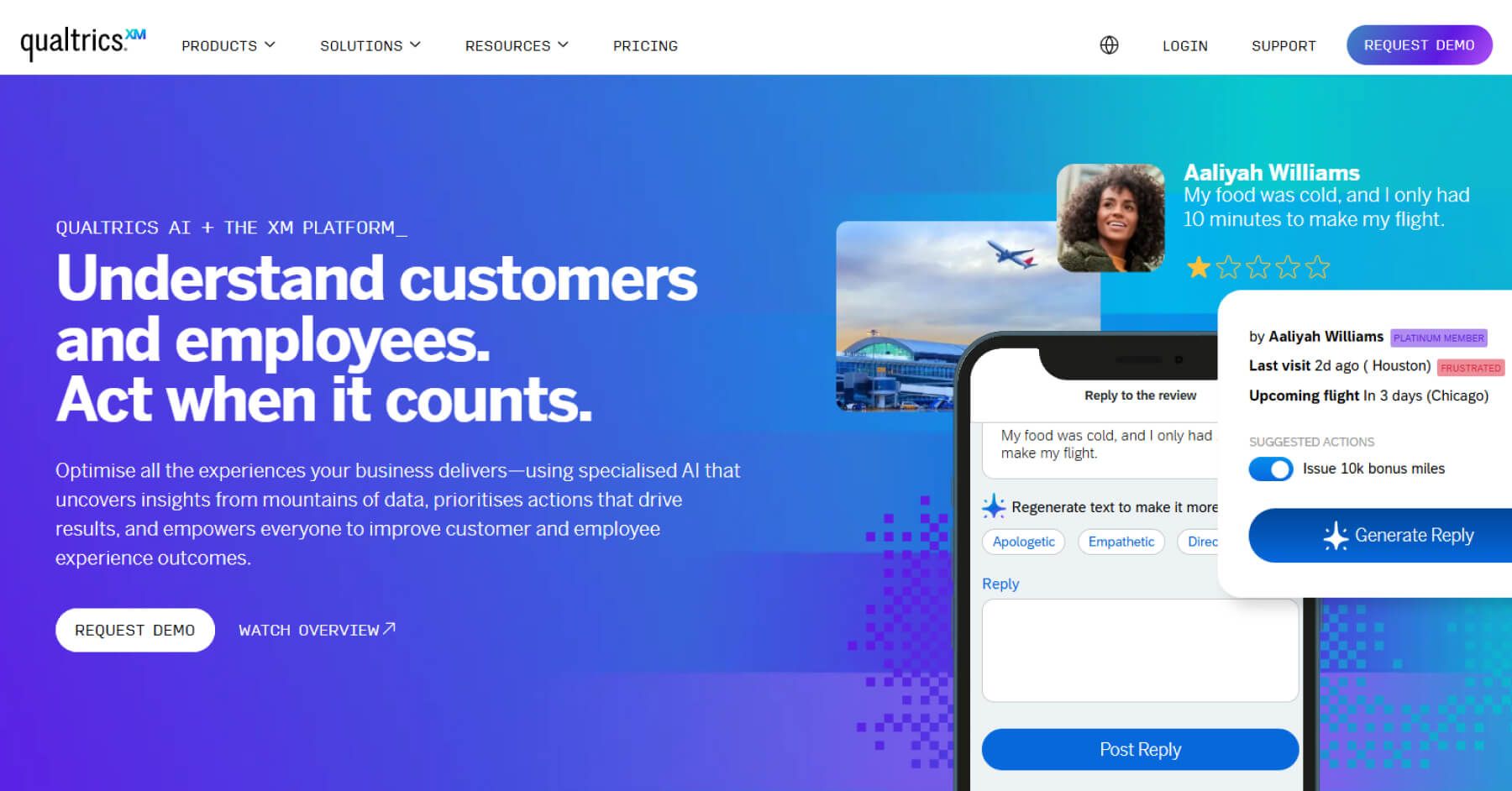
Qualtrics provides organizations with a suite of survey and experience management tools designed to capture feedback across the employee lifecycle. The platform supports engagement surveys, analytics dashboards, and benchmarking features to help HR teams track sentiment and organizational trends.
| Feature | Advantages |
|---|---|
| Pre-built engagement survey templates | Enables HR teams to quickly launch research-backed engagement surveys with minimal setup. |
| Hierarchy mapping for reporting | Supports parent-child or level-based org structures to filter responses by team or region. |
| Multi-mode survey types | Offers pulse, lifecycle, onboarding, exit, and census surveys for continuous feedback. |
| Action-planning dashboards | Visual dashboards highlight insights and guide managers through structured follow-up. |
| Benchmark comparisons | Enables benchmarking against global, industry, and Fortune 500 standards for context. |
Key Takeaways
| Takeaway | Details |
|---|---|
| Pricing | Contact sales |
| G2 score | 4.4 |
| Capterra score | Not available |
| Pros | Provides helpful benchmarking tools to compare engagement results against industry standards. |
| Cons | The platform can feel complex to learn and explain; pricing is on the higher side compared to peers. |
3. Glint
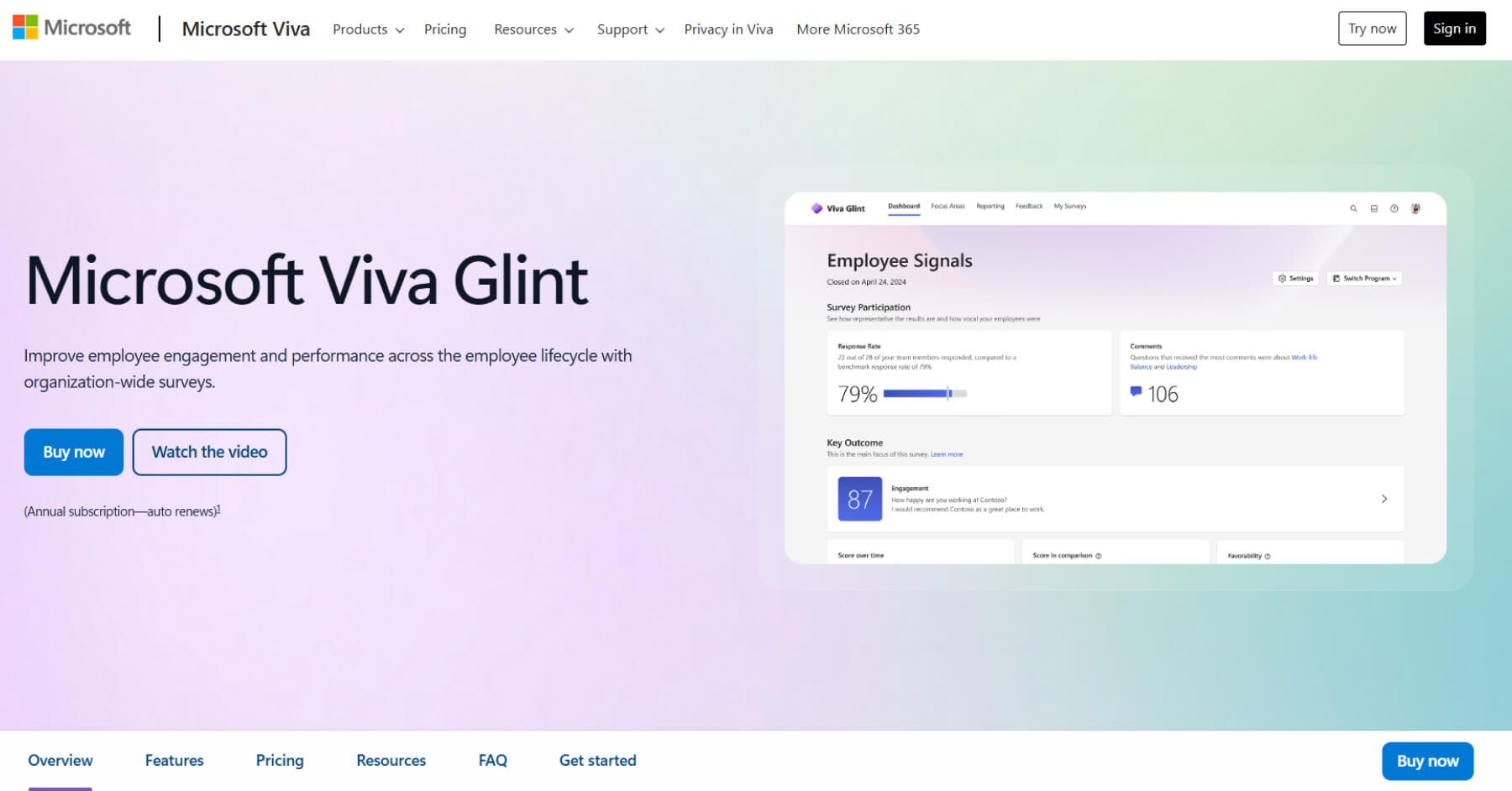
Viva Glint, part of Microsoft Viva, is an employee listening tool designed to help organizations measure and improve engagement. It combines surveys with AI-driven insights, making it easier for leaders to understand feedback at scale
| Feature | Advantages |
|---|---|
| Customizable survey templates | Create tailored engagement, lifecycle, and 360 surveys grounded in people science research. |
| Multi-tenant survey delivery support | Seamlessly deploy engagement surveys across multiple M365 tenants in large, complex organizations. |
| AI-powered comment summarization | Use Copilot to instantly summarize thousands of open-ended responses into actionable insights. |
| Visual analytics | Interactive dashboards and early warnings to flag engagement decline or attrition risks. |
| Email branding and personalization | Customize sender domain, include branding, and insert dynamic fields like department or manager name. |
Key Takeaways
| Takeaway | Details |
|---|---|
| Pricing | Contact sales |
| G2 score | 4.6 |
| Capterra score | 4.6 |
| Pros | Offers a straightforward interface with flexible analytics options that help HR teams review survey results effectively. |
| Cons | Some features can feel complex, requiring either advanced familiarity or support assistance for smooth use. |
4. Peakon
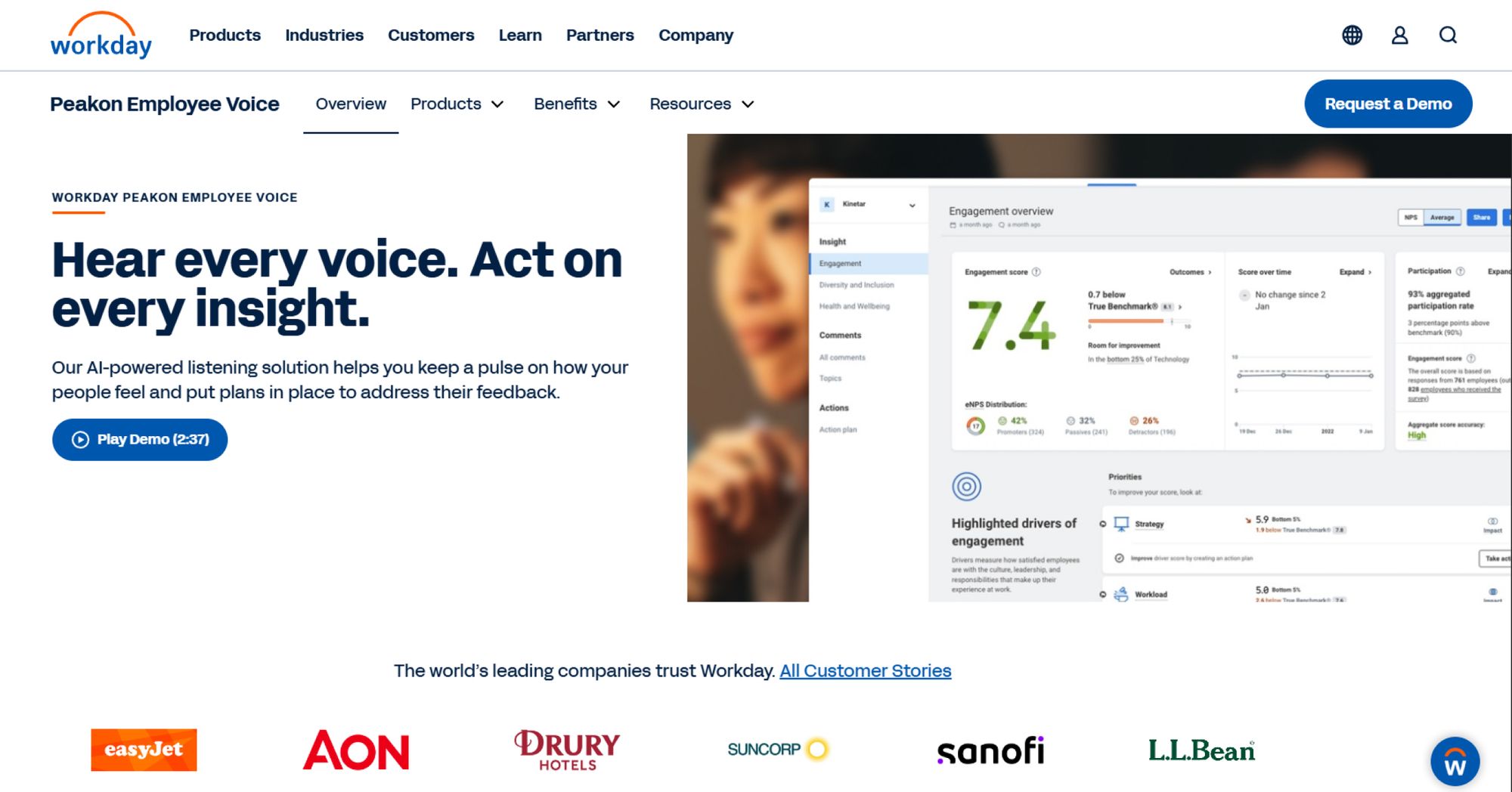
Workday Peakon Employee Voice is designed to capture employee feedback through dynamic surveys and AI-driven insights. It helps organizations track engagement trends, predict attrition risks, and benchmark results against industry peers.
| Feature | Advantages |
|---|---|
| Intelligent surveys | Delivers dynamic questions that adapt based on recent feedback for more meaningful interactions. |
| True Benchmarking | Compares engagement scores across demographic-adjusted industry norms. |
| Attrition prediction | Uses AI to forecast turnover risk across segments to help HR act proactively. |
| Contextual insights | Employs NLP for deep analysis of open-ended feedback to surface trends and themes. |
| AI summaries | Generates rapid comment summaries and insights by department or locale with generative AI. |
Key Takeaways
| Takeaway | Details |
|---|---|
| Pricing | Contact sales |
| G2 score | 4.6 |
| Capterra score | 4.8 |
| Pros | Offers a wide variety of survey questions that help cover multiple aspects of employee relations and organizational culture. |
| Cons | Considered expensive compared to alternatives; exporting raw data has some limitations, which can restrict deeper analysis. |
5. Officevibe
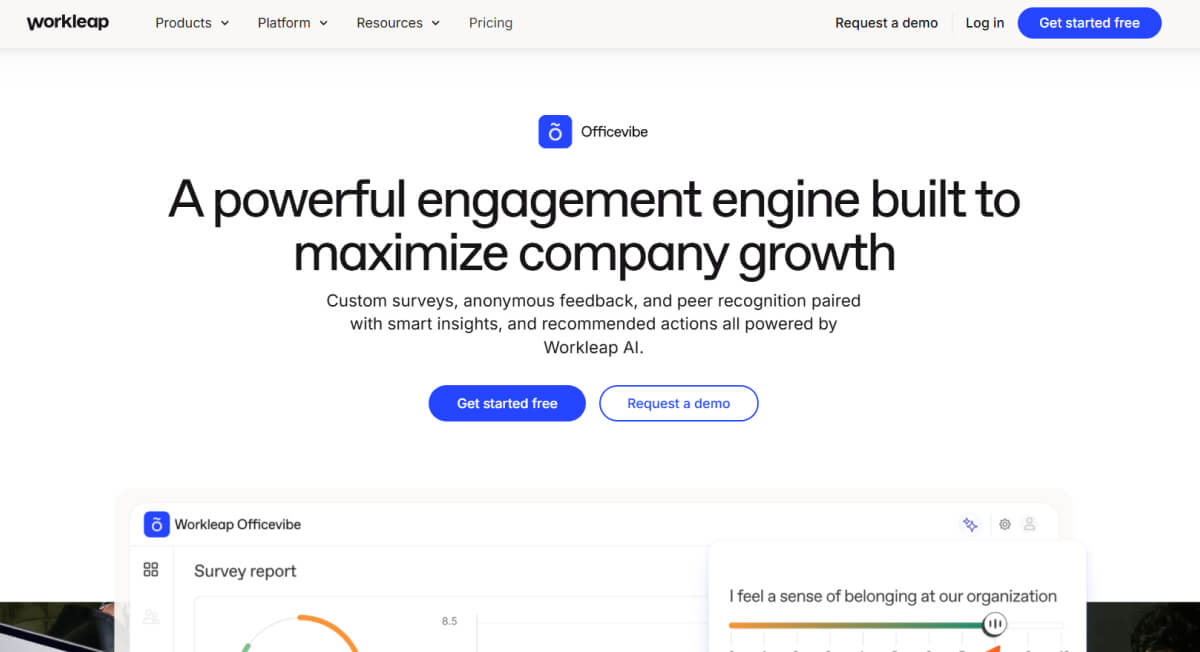
Workleap Officevibe brings pulse surveys, recognition tools, and AI-powered insights together in a simple platform. It helps HR teams capture anonymous feedback, celebrate wins, and spot engagement trends early, all within familiar tools like Slack and Microsoft Teams.
| Feature | Advantages |
|---|---|
| Pulse surveys | Send frequent, concise surveys to capture engagement in real time. |
| Anonymous feedback | Provides feedback with confidentiality to encourage honesty. |
| AI-powered insights | Automatically summarizes trends and feedback for quick understanding. |
| Peer recognition | Built-in tools for giving “Good Vibes” shout-outs to reinforce positive behaviors. |
| Slack/Teams integration | Seamlessly fits into daily workflows for easier engagement participation. |
Key Takeaways
| Takeaway | Details |
|---|---|
| Pricing | $5.00 per user/month |
| G2 score | 4.7 |
| Capterra score | 4.8 |
| Pros | Provides intuitive survey templates and real-time reporting, making it easier to collect and analyze employee feedback. |
| Cons | Customization for surveys might be limited and fewer integrations compared to other enterprise tools. |
6. Culture Amp
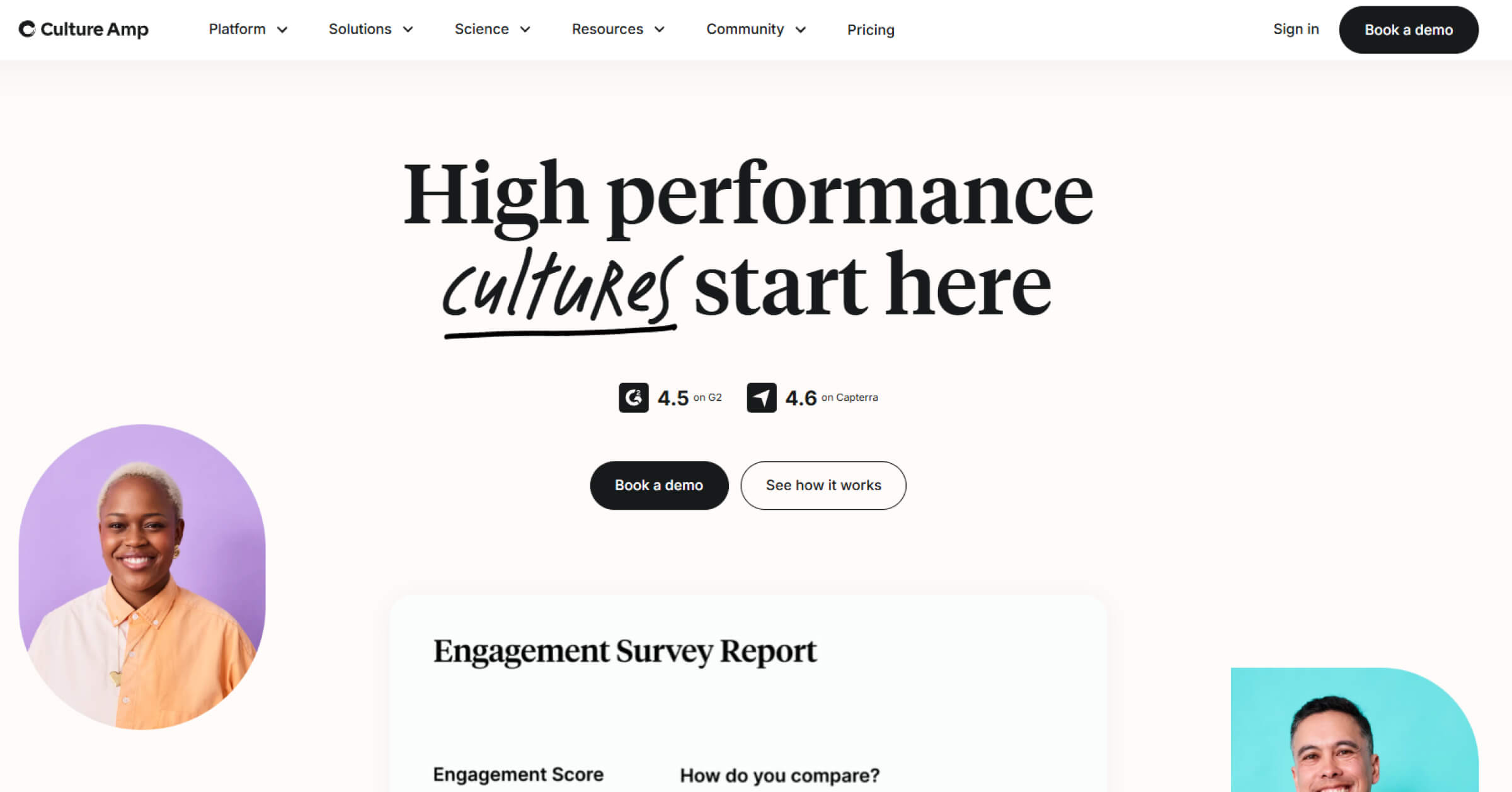
Culture Amp is an employee experience platform that combines engagement, performance, and development tools in one system. It helps organizations run surveys, analyze results, and plan actions to improve workplace culture.
| Feature | Advantages |
|---|---|
| Template Surveys | Provides research-based templates for onboarding, pulse, performance, and development surveys. |
| Deep Analytics | Offers dashboards, driver analysis, and benchmarking to pinpoint engagement trends. |
| Integrated Platform | Combines engagement, performance reviews, and development tools in a single experience. |
| HRIS Integrations | Designed to sync with major HR systems to simplify rollout and minimize manual tasks. |
| Action Planning | Supports data-informed action with insights that feed into manager and HR workflows. |
Key Takeaways
| Takeaway | Details |
|---|---|
| Pricing | Contact sales |
| G2 score | 4.5 |
| Capterra score | 4.6 |
| Pros | Easy to use with practical features, simplified reporting, and the ability to track score changes over time. |
| Cons | Insights often require staff guidance, and support response times may feel slow during urgent reporting needs. |
7. Leapsome
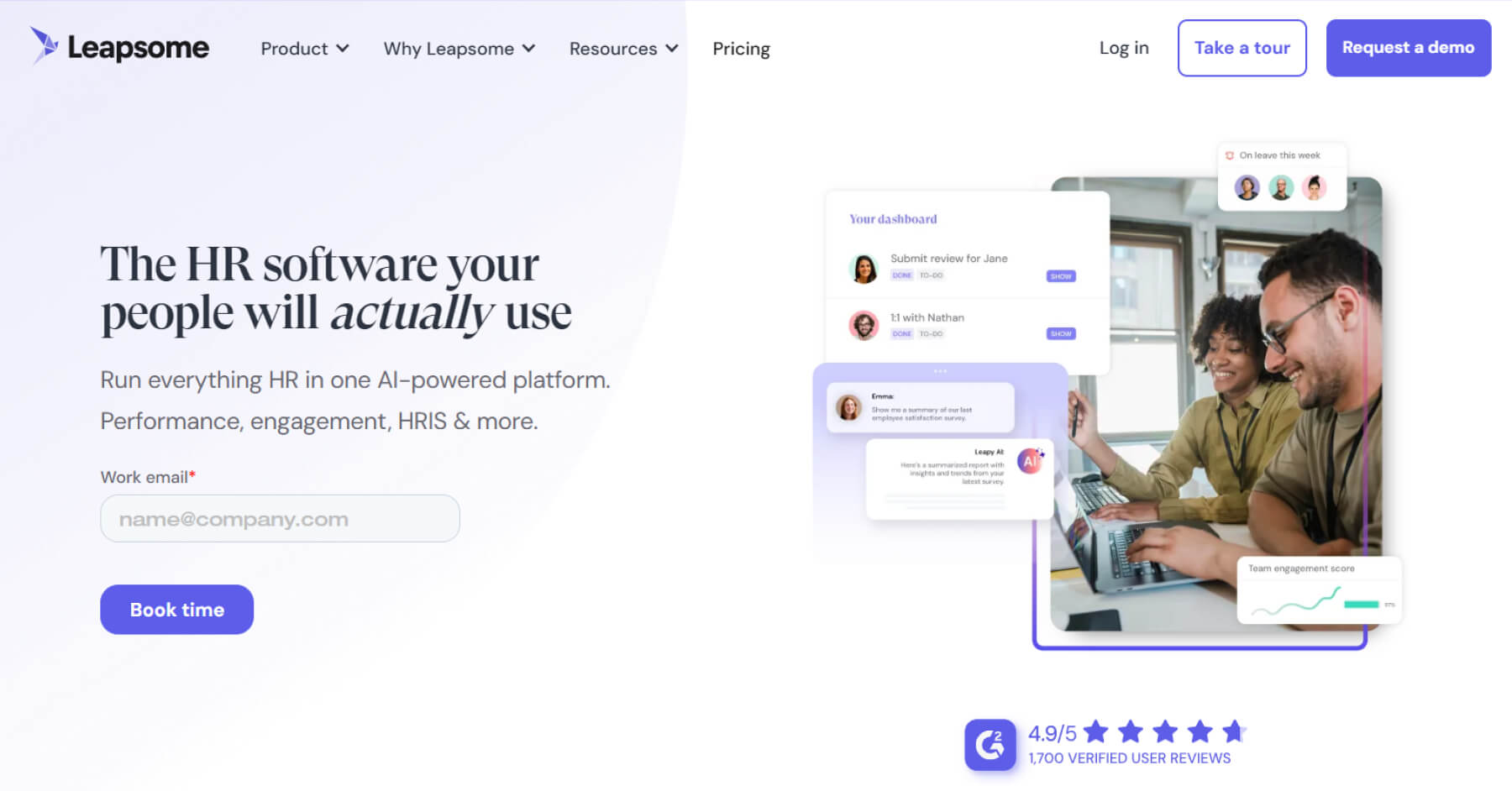
Leapsome is an all-in-one people enablement platform that helps businesses to unify HRIS, performance, engagement surveys, learning, and feedback workflows. Powered by AI, it aims to reduce admin complexity while empowering teams to grow within a cohesive feedback and development ecosystem.
| Feature | Advantages |
|---|---|
| HRIS suite | Secure core HRIS for employee data, time, payroll, and absence management. |
| Engagement surveys | Easy to set up pulse and engagement surveys with anonymity, recurrence, benchmarking, and AI insights. |
| Goals & OKRs | Align individual, team, and organization objectives with visual tracking and performance context.) |
| AI-powered insights | AI summaries, recommendations, and sentiment analysis uncover trends quickly. |
| Learning & feedback | Built-in tools for learning paths, 360° feedback, instant praise, and one-on-ones. |
Key Takeaways
| Takeaway | Details |
|---|---|
| Pricing | Contact sales |
| G2 score | 4.8 |
| Capterra score | 4.6 |
| Pros | Strong survey analytics with flexible filters and benchmark options that help HR teams interpret results effectively. |
| Cons | Some parts like survey logic and question branching could be more customizable for advanced use cases. |
8. Lattice
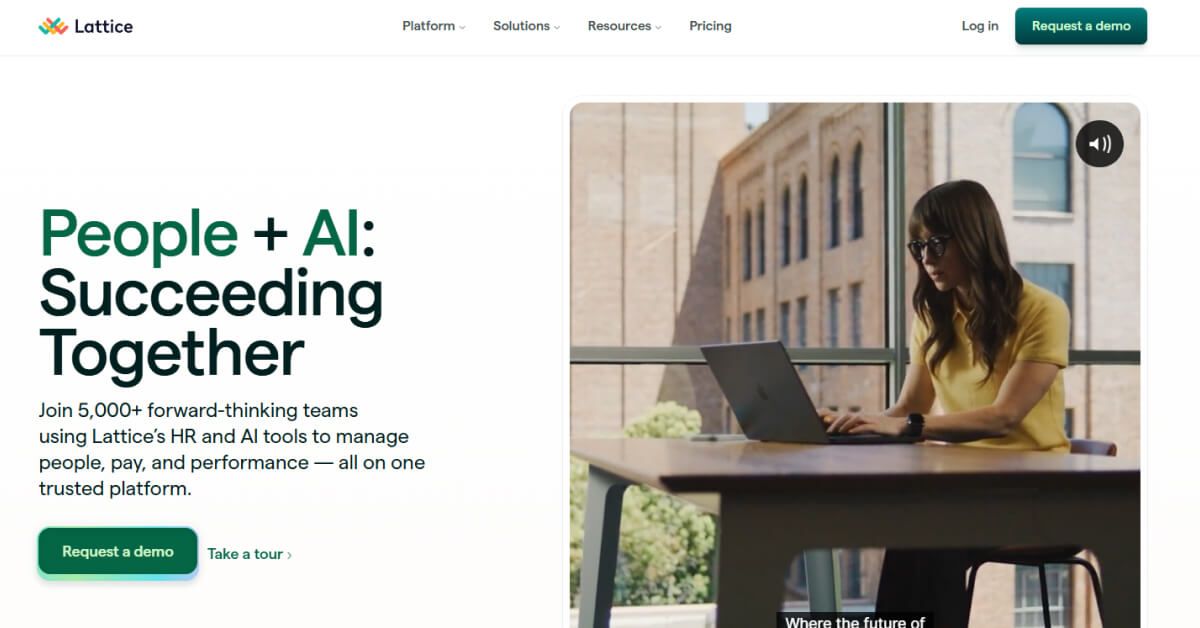
Lattice is a people-management platform that combines engagement, performance, and feedback tools into one scalable system. It supports continuous listening through pulse, onboarding/exit, and engagement surveys, fueled by AI and real-time analytics, for organizations that want to act on insights fast.
| Feature | Advantages |
|---|---|
| Pulse surveys | Run frequent, customizable checks to capture real-time team sentiment and engagement. |
| Survey branching | Use skip logic and multi-select questions to make surveys more relevant and concise. |
| AI analysis | Get instant insights from comments, sentiment, and themes with built-in AI features. |
| PPT export | Quickly turn survey data into presentation-ready decks by department or demographic. |
| Onboarding / Exit feedback | Automate lifecycle surveys with analytics to identify improvements from hire to exit. |
Key Takeaways
| Takeaway | Details |
|---|---|
| Pricing | Contact sales |
| G2 score | 4.7 |
| Capterra score | 4.5 |
| Pros | Easy-to-use interface, quick setup, and global adoption with API integrations. |
| Cons | Some users report frequent changes in customer reps, which may create inconsistency in support. |
How CultureMonkey powers automated, personalized employee survey emails
At enterprise scale, personalization and timing are everything. CultureMonkey makes it easy to send targeted, relevant, and timely survey emails without manual effort. From automation to analytics, the platform helps HR teams boost response rates and trust, all while staying aligned with global compliance needs.
Here’s how the CultureMonkey’s enterprise engagement platform delivers smart, scalable survey email experiences:
- Automated delivery based on employee lifecycle events: Trigger survey emails automatically at onboarding, exit, promotion, or tenure milestones, without writing a line of code.
- Dynamic email personalization at scale: Insert employee names, GIFs and images to create messages that feel personal, even when sent to thousands.
- Pre-built templates with best-practice tone: Use enterprise-tested subject lines and copy that improve engagement and avoid sounding robotic.
- Real-time tracking of open and completion rates: Know exactly who opened the email and who didn’t, so your follow-ups are always targeted and respectful.
- Automatic reminders to non-respondents: CultureMonkey handles the follow-up flow with warmth, no spammy chases, just timely nudges.
- Built-in compliance and data security: Every survey email follows GDPR, SOC 2, and enterprise-level privacy standards, giving both HR and employees peace of mind.
Conclusion
In large organizations, sending employee engagement survey emails is more than a task, it’s a strategic opportunity to build trust, drive culture, and collect insights that shape the employee experience. But without thoughtful communication, personalized delivery, and compliance safeguards, even the best surveys can go unanswered.
That’s where CultureMonkey comes in. As a leading engagement platform, CultureMonkey helps HR teams automate survey emails at scale, with the right tone, timing, and personalization for every employee.
From dynamic email templates to automated reminders and real-time analytics, it simplifies every touchpoint in the feedback loop. Most importantly, it ensures your messages are seen, trusted, and acted upon, without manual follow-up or compliance guesswork.
Summary
FAQs
1. What should I include in an employee engagement survey email?
An effective survey email should outline the purpose, estimated time, and reassure anonymity. Keep the tone clear and concise, with one strong call-to-action link. As part of your employee survey communication plan, use personalization, reminders, and segmentation via HR email automation tools to improve participation and ensure every employee feels their feedback truly matters.
2. How do I increase the open rate of my survey invitation emails?
To boost open rates, start with a clear and engaging subject line that instantly signals value to your survey participants. Keep the email short, highlight anonymity, and send at optimal times of the day. Testing different subject line variations helps you learn what resonates best. Sharing timely employee survey results later also builds credibility and trust, increasing future participation significantly.
3. When is the best time to send an employee engagement survey email?
The most effective time is typically mid-week, between Tuesday and Thursday, during late morning hours (10–11 AM). Avoid Mondays and Friday afternoons when inboxes are crowded or attention drops. Use engagement data from your employee engagement survey software to pinpoint optimal send times for different roles or time zones.
4. Should I personalize survey emails for different departments?
Yes. Personalizing engagement survey communication makes employees feel the message is relevant to them, which improves response rates. Tailoring an employee engagement email for departments or regions allows you to highlight context that matters most. For example, finance may value efficiency, while product teams care about collaboration. Using segmentation and employee engagement email templates ensures communication feels specific, timely, and worth responding to.
5. How many reminder emails should I send for a survey?
The sweet spot is usually two reminders. Sending too many can feel pushy, while too few may reduce survey responses. Best practice is one reminder after a few minutes or hours for early nudges, and another closer to the deadline. Using an engagement survey email template helps structure these reminders clearly, making them polite, time-bound, and effective without overwhelming participants.
6. What’s a good subject line for an employee survey invite?
Keep it short, friendly, and purpose-driven. Examples: “Your voice matters—2-minute survey” or “Help us improve your workday.” Avoid corporate jargon or robotic tone. You can also test urgency or personalization, like “A quick favor, [First Name]?” A/B test different subject lines using your survey mailer template to find your top performer.
7. How often should large companies send engagement survey emails?
For enterprises, quarterly is a good cadence for broad engagement surveys, with shorter pulse checks in between. Too many surveys can cause fatigue, while too few miss trends in employee satisfaction. A well-planned rhythm ensures you capture valuable feedback regularly without overwhelming staff. Embedding surveys into internal communications strategies keeps participation steady and feedback meaningful.


